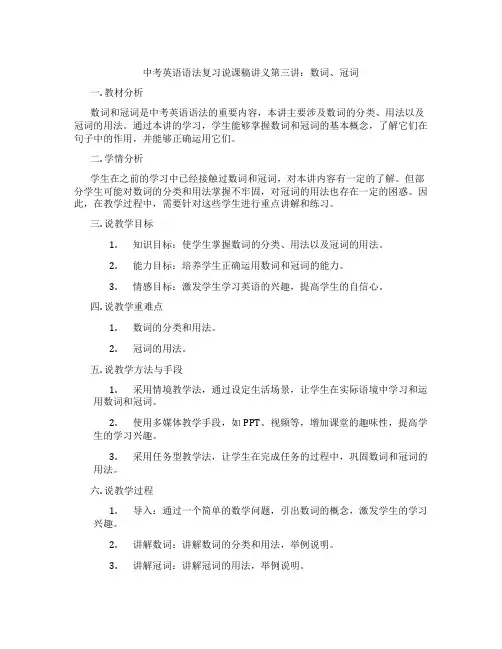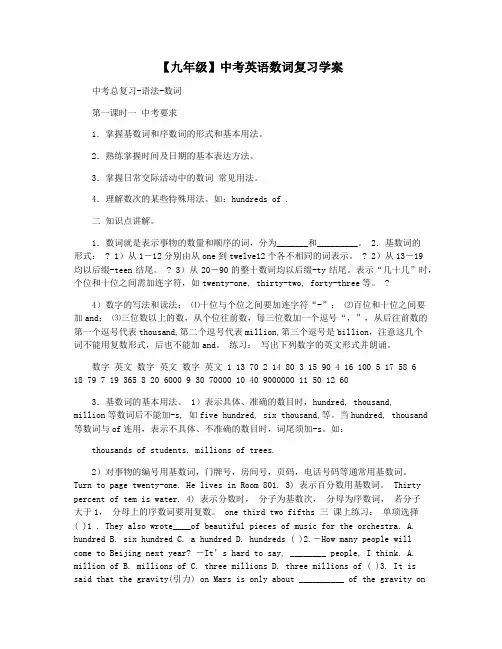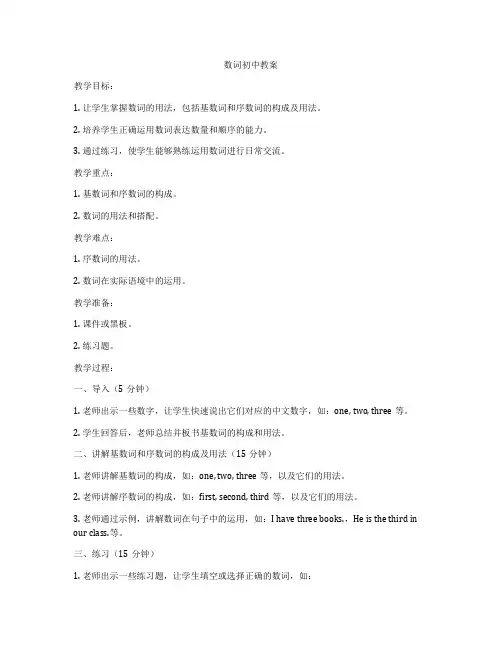中考复习之数词教案
- 格式:doc
- 大小:33.50 KB
- 文档页数:2

2017中考英语语法精讲:数词【教学目标】1.掌握基数词和序数词的用法2.学会分数和百分数的表达3.会表达年份【教学内容】数词分为基数词和序数词两种。
表示数目或数量多少的词叫基数词;表示数目顺序的词叫序数词。
一、基数词1.1―12的基数词是独立的单词,即: one,two,three,four,five,six,seven,eight,nine,ten,eleven,twelve。
2.13―19的基数词以-teen结尾。
如:fourteen,sev enteen等但13,15,18较特殊, 13―thirteen 15―fifteen 18―eighteen。
3.20―90的整十位均以-ty结尾。
如:sixty,ninety但20,30,40,50,80较特殊, 20―twenty 30―thirty 40―forty 50―fifty 80―eighty。
4.十位数与个位数之间要加连字符号“-”,如:28―twenty-eight,96―ninety-six。
5.百位和十位(若无十位则和个位)之间加and,如:148―one hundred and forty-eight 406―four hundred and six。
6.hundred(百),thousand(千),million(百万),billion(十亿)等前面即使有具体的数词,也不能在它们的后面加s。
如:600―six hundred,8百万―eight million。
7.1000以上的数字,从后往前数每三位加一个逗号“,”第一个逗号前为千(thousand),第二个逗号前为百万(million),第三个逗号前为billion(十亿)。
英语中无“万”这个词,我们可以用“几十个千(thousand)”表示几万,“几百个千(thousand)”表示“几十万”。
如:2,510=two thous and five hundred and ten;84,296=eight-four thousand two hundred and ninety-six;274,350=two hundred and seventy-four thousand three hundred and fifty。

初中数词教案教案一、教学目标:1. 让学生掌握数词的分类和基本用法,能够正确运用数词描述事物和数量。
2. 培养学生运用数词进行交流和思维的能力,提高学生的数学素养。
3. 通过对数词的学习,培养学生对数学的兴趣,激发学生的学习积极性。
二、教学内容:1. 数词的分类:整数、分数、小数、负数。
2. 数词的用法:表示数量、顺序、比例等。
3. 数词的运算:加减乘除、乘方、开方等。
三、教学重点与难点:1. 重点:数词的分类和基本用法。
2. 难点:数词的运算和应用。
四、教学方法:1. 情境教学法:通过生活实例和数学问题,让学生在实际情境中学习和运用数词。
2. 小组合作学习:让学生在小组内讨论和探究数词的用法和运算规律。
3. 游戏教学法:通过数词游戏,激发学生的学习兴趣,提高学生的学习积极性。
4. 任务驱动法:布置数学任务,让学生在完成任务的过程中,巩固数词知识和提高应用能力。
五、教学步骤:1. 导入新课:通过数数游戏,引导学生进入数词学习的情境。
2. 讲解数词分类:讲解整数、分数、小数、负数的定义和特点。
3. 演示数词用法:通过生活实例和数学问题,讲解数词表示数量、顺序、比例等。
4. 数词运算练习:讲解加减乘除、乘方、开方等运算规则,并进行练习。
5. 小组讨论:让学生在小组内讨论数词的用法和运算规律,分享学习心得。
6. 任务驱动:布置数学任务,让学生在完成任务的过程中,运用数词知识和提高应用能力。
7. 总结与反馈:对本节课的学习内容进行总结,对学生的学习情况进行反馈,查漏补缺。
六、课后作业:1. 复习数词的分类和基本用法。
2. 完成数词运算练习题。
3. 运用数词解决实际问题,如购物、测量等。
4. 总结数词的学习方法和技巧,撰写学习心得。
通过以上教学设计,相信学生能够掌握数词的基本知识和应用能力,激发对数学的兴趣,提高数学素养。
在教学过程中,教师要关注学生的个体差异,因材施教,使每个学生都能在数词学习中获得成功。

初中数词语法教案一、教学目标:1. 让学生掌握数词的分类和基本用法。
2. 培养学生正确运用数词描述物体数量、顺序和倍数的能力。
3. 提高学生对英语数词的认知水平,为后续学习打下基础。
二、教学内容:1. 数词的分类:基数词、序数词、分数词、倍数词。
2. 数词的用法:表示数量、顺序、倍数等。
3. 特殊数词的表达:零、半、整等。
三、教学重点与难点:1. 重点:数词的分类和基本用法。
2. 难点:特殊数词的表达和序数词的运用。
四、教学方法:1. 情境教学法:通过生活场景、故事等创设情境,让学生在实际语境中学习数词。
2. 任务型教学法:设计各种任务,让学生在完成任务的过程中运用数词。
3. 互动教学法:引导学生相互提问、交流,提高学生的口语表达能力。
五、教学步骤:1. 导入:以一幅图片或故事引入,激发学生的学习兴趣。
2. 讲解数词分类:讲解基数词、序数词、分数词、倍数词的概念和用法。
3. 特殊数词讲解:讲解零、半、整等特殊数词的用法。
4. 实例展示:用PPT或实物展示各种数词的用法,让学生加深理解。
5. 练习:设计各种练习题,让学生巩固所学知识。
6. 互动环节:学生相互提问、交流,提高口语表达能力。
7. 总结:对本节课的内容进行总结,强调重点和难点。
8. 作业布置:布置适量作业,让学生巩固所学知识。
六、教学评价:1. 课堂表现:观察学生在课堂上的参与程度、发言情况等。
2. 练习完成情况:检查学生练习题的完成情况,了解掌握程度。
3. 作业反馈:批改学生作业,发现问题并及时给予指导。
4. 口语表达能力:通过课堂互动、课后交流等途径,评价学生的口语表达能力。
通过以上教学设计,相信学生能够较好地掌握数词的知识和用法,提高英语水平。
在实际教学中,教师应根据学生的实际情况灵活调整教学方法,确保教学效果。

专题四数词数词表示数目和顺序,可分为基数词和序数词两类,基数词表示数目,序数词表示顺序。
一、基数词的形式二、序数词的形式1、一般在基数词后加⁃th。
但有些词要特殊记忆。
第一(first),第二(second),第三(third),第五(fifth ),第八(eighth),第九(ninth),第十二(twelfth)2、整十位数的序数词的写法应将基数词词尾的y 变为i 再加⁃eth。
twenty—twentieth,ninety—ninetieth两位或两位以上的基数词变序数词时,只把个位数上的基数词变成序数词即可。
twenty⁃one—twenty⁃first【一招制胜】一、二、三要单独记,one—first,two—second,three—thirdth 要从四加起,eight 少个t,nine 去掉e,ve 要用f 来代替,ty 变成tie,若问“几十几”或“几百几”,只变个位记心里。
注意:序数词前一般要加定冠词the。
三、分数表示法分子用基数词,分母用序数词;分子是1,分母用单数;分子大于1,分母用复数。
1/4→one fourth 或a quarter 1/2→a half 或one half3/4→three fourths 或three quarters 2/5→two fifths11 —→one and one fifth5分数做主语时,谓语动词的单复数应由of 后面名词的单复数来确定。
①of the work is hard to do. 五分之三的工作非常难做。
Three quarters of teachers in our school are women teachers.我们学校四分之三的老师是女教师。
巧记分数表示法基数词表示分子,分母要用序数词。
分子如果大于1,序数词尾加“s”。
二分之一是一半,a half 便可知。
四分之一很好说,a quarter 就很妥。
three fourths 七成半,意思是四分之三;还有一种表示法,three quarters 很习惯。

中考数词+介词+形容词副词教学案数词★ 基数词(1)1-12 特殊记: one, two, three…13-19+ :thirteen, fourteen… 20,30…90+: thirty, forty, fifty…(2)百位十位个位(3)hundred/ thousand/ dozen 等前有,后不加与;前有数字,后无s,但后面名词前有时有即:two hundred students hundreds of studentstwo hundred of the students★ 序数词(1)1、2、3 特殊记:8 去:9 去:ve 要用替:见y变成:若是碰见几十几,只★ 用法(1)时间三点钟:九点四十五:五点半:(2)分数表达法:,分子大于一,。
如三分之一:onethird;三分之二two thirds.(3)日期表达法:;如2008 年8 月8 日:August eighth, 2008;eighth of August, 2008(4)编号:32 号房;第一课;11 路公交车(5)年代:: in the 1990s, in the 1990’s年龄:: in his twenties(6)数量+时间/距离的所有格+名词:a two-hour drive=(7)几个半:一个半小时;两个半小时;介词★ 地点介词a.某地arrive 大地点arrive 小地点b.穿越内部穿表面穿跨越c.前前后后在外部的前面在里面的前面在外部的后面在里面的后面d.上上下下在…上面,有接触面在…下面,有接触面在…上面,垂直在…下面,垂直在斜上方;高于在斜下方;低于e.中间两者间大于等于三者间f.区域介词在中国的内部与中国相邻并接壤与中国相邻但不接壤g.旁边紧靠....旁边在.....旁边在..附近h.空中阳光影在空中在阳光在影子★ 时间介词a.在早午晚年月季节前注意:加一段时间可以表,与连用。
b.在星期日子修饰前c.在黎明午夜点钟年龄前d.on/in/at 不用于下列时间之前这个那个上个下个每个今天昨天明天今晚e.从某时开始,延续到现在,与完成时连用f.持续,加时间段g.从...... 开始h.在..... 一段期间★ 方式介词具体工具或手段墨水/语言交通工具或一种方式,后接名词前不加冠词后不加s;也可加动名词★ 易混淆介词长在树上在树上挂在墙上看得出原材料对. 怒吼嵌在墙里看不出原材料对. 大喊在..某地制造It’s adj. sb. to do 形容词表示人的性格特征It’s adj. sb. to do 形容词与人无关+ 交通工具+ 修饰(如冠词a/the;所有格后)+ 交通工具在……尽头最后(单独使用)……结束前(常与或连用)+穿着衣服/颜色/戴着衣帽+ 戴着饰品/身上带伤疤在拐角上在拐角处在拐角里迫在眉睫的除了(-)除了(+)美中不足唯一选择☆ 固定搭配留心,注意……对……做贡献喜欢…胜过和……谈话试穿期待打开/关上/调小声形容词副词☆ 形容词副词的定义、构成及位置1. 定义及位置:用于修饰或描述,表示人或物的性质、状态和特征等,放在前,后。

初中数词的教案教学目标:1. 让学生掌握数词的用法,能够正确表达数量和顺序。
2. 培养学生运用数词进行实际交流的能力。
3. 提高学生对日语数词的兴趣和积极性。
教学内容:1. 数词的分类和用法2. 数词的连用形式3. 数词的实际应用教学步骤:一、导入(5分钟)1. 老师出示一些日用品,如苹果、书本、椅子等,让学生猜测它们的数量。
2. 学生回答后,老师用日语回答,并板书相应的数词。
二、数词的分类和用法(15分钟)1. 老师讲解数词的分类,包括基本数词(1-10)、复合数词(11-99)、分数、小数和序数词。
2. 学生跟读并模仿,老师纠正发音。
3. 老师用例句讲解数词的用法,如:“我有一个苹果。
”、“她买了三本书。
”三、数词的连用形式(15分钟)1. 老师讲解数词的连用形式,如“~本”、“~个”、“~人”等。
2. 学生跟读并模仿,老师纠正发音。
3. 老师用例句讲解数词的连用形式,如:“我有两本书。
”、“她有三个人。
”四、数词的实际应用(15分钟)1. 老师出示一些场景,如购物、点餐等,让学生用数词进行实际交流。
2. 学生分组进行角色扮演,用数词进行交流。
3. 老师选取一些学生的交流情况进行点评和纠正。
五、总结与作业(5分钟)1. 老师对本节课的数词进行总结,强调重点和难点。
2. 学生做课堂作业,巩固所学内容。
教学评价:1. 课后收集学生的课堂作业,检查他们对数词的掌握情况。
2. 在下一节课开始时,让学生进行数词的口头测试,检验他们的实际应用能力。
3. 根据学生的表现,给予适当的奖励和鼓励,提高他们的学习积极性。
教学反思:本节课通过讲解和实际应用,让学生掌握了数词的用法。
在教学过程中,要注意纠正学生的发音,确保他们能够准确地表达数量和顺序。
同时,通过实际应用场景,让学生更好地理解和运用数词。
在今后的教学中,可以增加一些有趣的练习和活动,如数词接龙、数词猜谜等,提高学生对数词的兴趣和积极性。

中考英语语法复习说课稿讲义第三讲:数词、冠词一. 教材分析数词和冠词是中考英语语法的重要内容,本讲主要涉及数词的分类、用法以及冠词的用法。
通过本讲的学习,学生能够掌握数词和冠词的基本概念,了解它们在句子中的作用,并能够正确运用它们。
二. 学情分析学生在之前的学习中已经接触过数词和冠词,对本讲内容有一定的了解。
但部分学生可能对数词的分类和用法掌握不牢固,对冠词的用法也存在一定的困惑。
因此,在教学过程中,需要针对这些学生进行重点讲解和练习。
三. 说教学目标1.知识目标:使学生掌握数词的分类、用法以及冠词的用法。
2.能力目标:培养学生正确运用数词和冠词的能力。
3.情感目标:激发学生学习英语的兴趣,提高学生的自信心。
四. 说教学重难点1.数词的分类和用法。
2.冠词的用法。
五. 说教学方法与手段1.采用情境教学法,通过设定生活场景,让学生在实际语境中学习和运用数词和冠词。
2.使用多媒体教学手段,如PPT、视频等,增加课堂的趣味性,提高学生的学习兴趣。
3.采用任务型教学法,让学生在完成任务的过程中,巩固数词和冠词的用法。
六. 说教学过程1.导入:通过一个简单的数学问题,引出数词的概念,激发学生的学习兴趣。
2.讲解数词:讲解数词的分类和用法,举例说明。
3.讲解冠词:讲解冠词的用法,举例说明。
4.实践练习:设置一些练习题,让学生在实际语境中运用数词和冠词。
5.总结:对本讲内容进行总结,强调数词和冠词的重要性和用法。
6.作业布置:布置一些相关的练习题,巩固所学知识。
七. 说板书设计板书设计要清晰、简洁,能够突出本讲的重点。
主要包括数词的分类、用法和冠词的用法。
八. 说教学评价通过课堂表现、练习题和作业来评价学生的学习效果。
对学生在数词和冠词方面的掌握情况进行全面评估,发现问题,及时进行反馈和讲解。
九. 说教学反思在教学过程中,要不断反思自己的教学方法和手段,根据学生的实际情况进行调整。
同时,要关注学生的学习进度,确保每个学生都能掌握数词和冠词的用法。

初中数词教案一、教学目标:1. 让学生掌握数词的分类和用法,包括整数、分数、小数和序数词。
2. 培养学生正确运用数词进行表达和交流的能力。
3. 通过对数词的学习,培养学生对数学的兴趣和爱好。
二、教学内容:1. 数词的分类:整数、分数、小数和序数词。
2. 数词的用法:表示数量、顺序、比例等。
3. 数词在实际生活中的应用:数学计算、数据分析、科学研究等。
三、教学过程:1. 导入:通过引导学生观察和描述教室内的物品数量,引出数词的概念。
2. 讲解:(1)整数:介绍正整数、负整数和零的概念,引导学生理解整数的性质和用法。
(2)分数:讲解分数的定义、分数的性质和分数的运算,让学生掌握分数的表达和计算方法。
(3)小数:介绍小数的意义、小数的位数和大小比较,引导学生掌握小数的表达和运用。
(4)序数词:讲解序数词的定义、用法和序数词的构成,让学生能够正确使用序数词表示顺序。
3. 练习:通过课堂练习和小组讨论,让学生巩固数词的知识,提高运用数词的能力。
4. 应用:结合实际生活中的例子,让学生了解数词在数学计算、数据分析和科学研究等方面的应用。
5. 总结:对本节课的数词知识进行总结,强调数词的重要性和运用。
四、教学方法:1. 采用直观演示法,通过实物和图片等引导学生直观地理解数词的概念。
2. 采用讲解法,详细讲解数词的分类、用法和实际应用。
3. 采用练习法,通过课堂练习和小组讨论,巩固数词知识,提高运用能力。
4. 采用情境教学法,结合实际生活中的例子,让学生学会运用数词解决实际问题。
五、教学评价:1. 课堂问答:检查学生对数词知识的掌握程度。
2. 课堂练习:评估学生在实际应用中运用数词的能力。
3. 课后作业:布置相关数词的练习题,巩固所学知识。
4. 小组讨论:评价学生在团队合作中数词的表达和运用能力。
六、教学拓展:1. 引导学生参加数学竞赛,提高数词运用能力。
2. 组织数学实践活动,如数学解密、数据分析等,让学生在实践中运用数词。

【九年级】中考英语数词复习学案中考总复习-语法-数词第一课时一中考要求1.掌握基数词和序数词的形式和基本用法。
2.熟练掌握时间及日期的基本表达方法。
3.掌握日常交际活动中的数词常见用法。
4.理解数次的某些特殊用法。
如:hundreds of .二知识点讲解。
1.数词就是表示事物的数量和顺序的词,分为_______和_________。
2.基数词的形式: ? 1)从1-12分别由从one到twelve12个各不相同的词表示。
? 2)从13-19均以后缀-teen结尾。
? 3)从20-90的整十数词均以后缀-ty结尾。
表示“几十几”时,个位和十位之间需加连字符,如twenty-one, thirty-two, forty-three等。
?4)数字的写法和读法:⑴十位与个位之间要加连字符“-”;⑵百位和十位之间要加and;⑶三位数以上的数,从个位往前数,每三位数加一个逗号“,”,从后往前数的第一个逗号代表thousand,第二个逗号代表million,第三个逗号是billion,注意这几个词不能用复数形式,后也不能加and。
练习:写出下列数字的英文形式并朗诵。
数字英文数字英文数字英文 1 13 70 2 14 80 3 15 90 4 16 100 5 17 58 618 79 7 19 365 8 20 6000 9 30 70000 10 40 9000000 11 50 12 603.基数词的基本用法。
1)表示具体、准确的数目时,hundred, thousand,million等数词后不能加-s, 如five hundred, six thousand,等。
当hundred, thousand 等数词与of连用,表示不具体、不准确的数目时,词尾须加-s。
如:thousands of students, millions of trees.2)对事物的编号用基数词,门牌号,房间号,页码,电话号码等通常用基数词。

数词初中教案教学目标:1. 让学生掌握数词的用法,包括基数词和序数词的构成及用法。
2. 培养学生正确运用数词表达数量和顺序的能力。
3. 通过练习,使学生能够熟练运用数词进行日常交流。
教学重点:1. 基数词和序数词的构成。
2. 数词的用法和搭配。
教学难点:1. 序数词的用法。
2. 数词在实际语境中的运用。
教学准备:1. 课件或黑板。
2. 练习题。
教学过程:一、导入(5分钟)1. 老师出示一些数字,让学生快速说出它们对应的中文数字,如:one, two, three等。
2. 学生回答后,老师总结并板书基数词的构成和用法。
二、讲解基数词和序数词的构成及用法(15分钟)1. 老师讲解基数词的构成,如:one, two, three等,以及它们的用法。
2. 老师讲解序数词的构成,如:first, second, third等,以及它们的用法。
3. 老师通过示例,讲解数词在句子中的运用,如:I have three books.,He is the third in our class.等。
三、练习(15分钟)1. 老师出示一些练习题,让学生填空或选择正确的数词,如:(1)I have _____ apples.A. fiveB. 5(2)She is the _____ student in our class.A. secondB. 22. 学生完成后,老师讲解答案并给予反馈。
四、巩固(10分钟)1. 老师组织学生进行小组活动,用数词进行简单的交流,如:介绍自己的家庭成员、描述物品的数量等。
2. 学生展示交流成果,老师给予评价和指导。
五、总结(5分钟)1. 老师引导学生总结本节课所学的内容,如:基数词和序数词的构成、用法等。
2. 学生分享学习收获。
六、作业(课后)1. 抄写本节课所学的数词,每个写5遍。
2. 运用数词写一篇小短文,描述自己的日常生活。
教学反思:本节课通过讲解、练习、交流等方式,使学生掌握了数词的用法。
中考复习之数词
刘静怡
一、 教学目标
本课时主要让学生复习数词的各种表达法,数词主要分为基数词和序数词。
通过本课时的学习,让学生可以将数词运用到如何表达日期、时间、分数等
中去。
二、 教学重、难点
1、 基数词与序数词的比较
2、 基数词与序数词的表达法
3、 年份以及日期的表达
三、 Presentation(课堂呈现)
Step1. Greeting
Step2. Lead-in
A song named
Ten little Indian boys.
Step3. Review the Identify of Numerals. (学习数词的定义)
英语数词表示数目或顺序,可分为基数词和序数词。基数词表示数量,序
数词表示顺序。序数词与定冠词the连用。
Step4. Compare Cardinal Numbers with Ordinal Numbers(基数词与序数
词进行比较)
1.让学生找出所给出的数词的规律。
2.对所找出的规律用一段话进行归纳。
3. Do some exercises.
Step5. Other characters of Cardinal Numbers(数词的其他特点)
1.一百以上数词的表达方法。
2.尤其要注意在英语中没有“万”与“亿”这两个单位,“万”用
“十个千”,即ten thousand表示,“亿”用 “100个百万”,即
100million表示;1000以上数目,从右向左每三位用“,”分开,分
别为千thousand, 百万million, 十亿billion.
Step6. The expressions of the date and the year(年份、日期的表达
法)
1.举例说明怎样表达年份和日期。
2. Make a card
Step7. Do some exercises
Step8. Summary
1、基数词与序数词的对比。
2、数词的其他特点。
3、年份、日期表达法
Step9. Homework